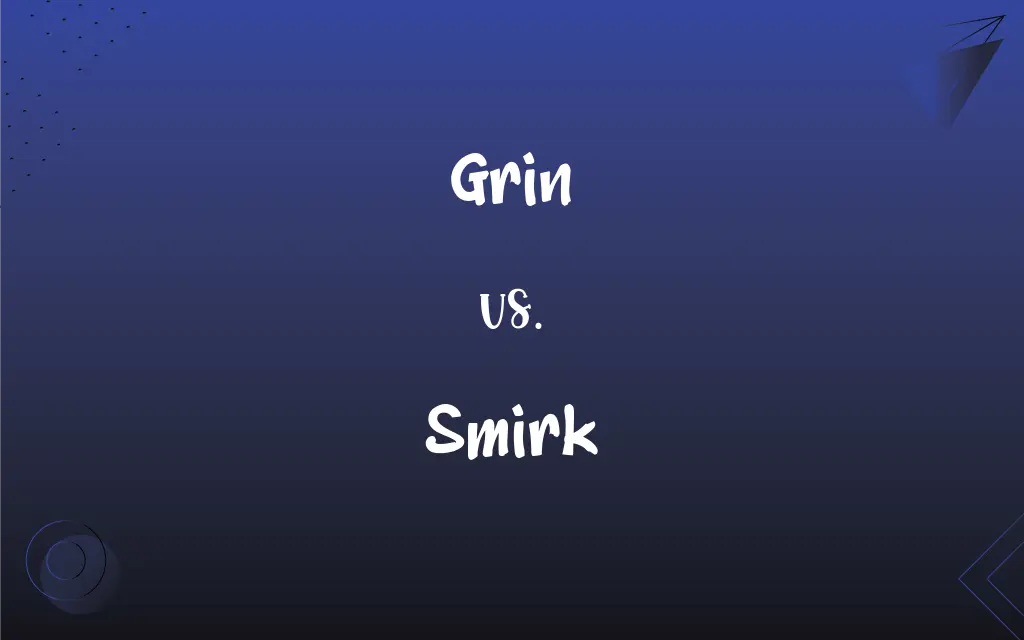Grin vs. Smirk: What's the Difference?
Edited by Aimie Carlson || By Janet White || Updated on January 25, 2024
A grin is a broad, often open-mouthed smile expressing delight or amusement, while a smirk is a half-smile suggesting smugness, scorn, or insincerity.

Key Differences
Grins and smirks are both facial expressions but differ in their emotional contexts. A grin is typically a wider, more expressive smile often associated with genuine happiness or humor. In contrast, a smirk is a smaller, more one-sided smile, frequently perceived as insincere, smug, or scornful.
The use of grin and smirk in social situations varies significantly. A grin is usually seen as friendly and welcoming, indicating a positive emotion or reaction. On the other hand, a smirk can be interpreted as disrespectful or derisive, often used to convey a sense of superiority or amusement at someone else's expense.
Body language experts often differentiate between grins and smirks based on the muscles used. A genuine grin involves the muscles around the mouth and eyes, creating a warm, engaging expression. In contrast, a smirk is more controlled, typically involving only the muscles around one corner of the mouth.
In literature and art, grins are often used to portray characters as likable, joyful, or playful. Conversely, smirks are used to depict sarcasm, arrogance, or deceit, adding layers to character development.
In everyday communication, understanding the difference between a grin and a smirk is crucial for interpreting others' intentions and emotions correctly. A misinterpretation of these expressions can lead to misunderstandings in both personal and professional contexts.
ADVERTISEMENT
Comparison Chart
Emotional Context
Joy, amusement, friendliness
Smugness, scorn, insincerity
Symmetry
Symmetrical, involves both sides of the face
Often asymmetrical, one side of the face
Mouth Opening
Can be open or closed, but broadly stretched
Usually closed, slight upward curve
Eye Involvement
Often involves crinkling around the eyes
Rarely involves the eyes
Social Perception
Generally positive, warm
Often negative, seen as smug or sarcastic
ADVERTISEMENT
Grin and Smirk Definitions
Grin
An expression of joy or pleasure with a wide smile.
The child's innocent grin lit up the room.
Smirk
A smug, conceited, or silly smile.
He gave a smirk after outsmarting his opponent.
Grin
A broad, often open-mouthed smile expressing delight.
His joke made me burst into an uncontrollable grin.
Smirk
A subtle, mocking smile conveying contempt or superiority.
The teacher's smirk at the incorrect answer embarrassed the student.
Grin
A wide smile showing teeth, typically in happiness or amusement.
She wore a proud grin after winning the race.
Smirk
A small, often ironic smile suggesting arrogance.
His smirk was unmistakable when he mentioned his success.
Grin
A large, often exaggerated smile, usually expressing excitement.
Her grin widened as she opened the surprise gift.
Smirk
A half-smile indicating self-satisfaction or scorn.
She couldn't hide her smirk when she proved them wrong.
Grin
A facial expression of happiness, often informal and spontaneous.
He greeted me with a warm, friendly grin.
Smirk
An insincere, complacent smile often perceived as irritating.
His constant smirk during the debate was off-putting.
Grin
To smile broadly, often baring the teeth, as in amusement, glee, embarrassment, or other strong emotion.
Smirk
To smile in an annoying self-satisfied manner.
Grin
To express with a grin
I grinned my approval.
Smirk
An annoying self-satisfied smile.
FAQs
What emotions does a grin typically convey?
A grin often conveys happiness, amusement, or joy.
Can a grin be insincere?
While usually genuine, grins can sometimes be forced or insincere.
Is a grin more socially acceptable than a smirk?
Yes, a grin is generally more socially acceptable as it's seen as friendly.
Do grins always show teeth?
Not necessarily, but grins often involve showing teeth.
Is a smirk always intentional?
Smirks can be both intentional and unintentional.
Is a smirk always negative?
Generally, a smirk is perceived negatively, suggesting smugness or sarcasm.
Are there health benefits to grinning?
Yes, grinning can reduce stress and improve mood.
Can cultural differences affect how grins and smirks are perceived?
Yes, cultural contexts can influence the interpretation of these expressions.
Does a smirk involve the eyes?
A smirk usually doesn't involve the eyes and is mostly a mouth movement.
Is it possible to misinterpret a smirk as a grin?
Yes, without context, these expressions can sometimes be misinterpreted.
Can someone grin or smirk in their sleep?
It's possible, though these expressions in sleep might not hold the same meaning.
Do grins and smirks play a role in attraction?
Yes, they can play a role in non-verbal flirtation or showing interest.
Do children smirk and grin differently from adults?
Yes, children's expressions can be more spontaneous and less controlled.
Are grins and smirks universal in human communication?
Yes, these expressions are commonly found across different cultures.
How do actors use grins and smirks in performances?
Actors use these expressions to convey a range of emotions and character traits.
Can both expressions be used interchangeably?
No, due to their different emotional connotations, they are not interchangeable.
Can a smirk be a sign of nervousness?
Sometimes, a smirk might be a nervous reaction rather than smugness.
Are there any famous literary characters known for grinning or smirking?
Yes, characters like the Cheshire Cat in "Alice in Wonderland" are famous for grinning.
Can animals grin or smirk?
Animals can display similar expressions, but the meanings might differ.
Can a person's grin or smirk change over time?
Yes, as people age or their personalities change, their expressions can evolve.
About Author
Written by
Janet WhiteJanet White has been an esteemed writer and blogger for Difference Wiki. Holding a Master's degree in Science and Medical Journalism from the prestigious Boston University, she has consistently demonstrated her expertise and passion for her field. When she's not immersed in her work, Janet relishes her time exercising, delving into a good book, and cherishing moments with friends and family.
Edited by
Aimie CarlsonAimie Carlson, holding a master's degree in English literature, is a fervent English language enthusiast. She lends her writing talents to Difference Wiki, a prominent website that specializes in comparisons, offering readers insightful analyses that both captivate and inform.































































